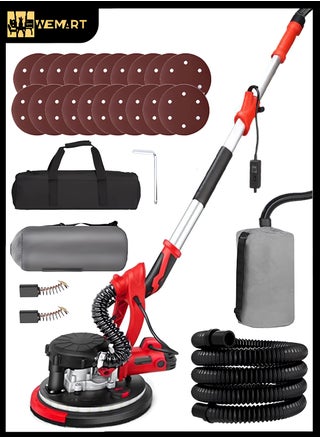Free & Easy Returns
Best Deals






1. Daily Maintenance After Use
Cleaning the Body and Parts
Clean surface dust immediately after use to prevent dust from clogging the heat dissipation vents or entering the motor.
Use compressed air to blow out internal gaps (note that this must be done with the power off).
Residue on the sandpaper tray should be cleaned to prevent clumping and interfering with subsequent use.
Checking the Condition of the Sandpaper
Replace severely worn sandpaper promptly to ensure even and effective sanding.
If using self-adhesive sandpaper, clean any glue spots on the tray to keep it sticky.
Checking Screws and Parts
Tighten loose screws (such as handles and sandpaper fittings) to prevent them from falling out during operation due to vibration.
Ensure that the protective cover is securely fastened to prevent accidental damage.
2. In-depth Periodic Maintenance
Lubrication of Key Areas
Apply a small amount of special grease (such as lithium-based grease) to moving parts such as bearings and gears every three months to reduce friction losses.
Avoid over-lubrication to prevent dust absorption and deposit formation.
Check Motor Carbon Brushes
Check the length of the carbon brush every 2-3 months and replace it when it reaches 1/3 of its original length.
When replacing, pay attention to model matching and ensure good contact with the motor.
Check the Drive System
Belt-driven machines: Adjust the belt tightness; if it's too tight, it will increase the load, and if it's too loose, it will cause slippage.
Gear-driven machines: Check the gear meshing and clean out any debris.
Circuit Integrity Check
Regularly check the power cord for damage or loose connectors.
If the machine has an overheat protection function, test it to ensure it's operating normally.
3. Storage Precautions
Environment Selection
Store in a dry, dust-free place to avoid moisture that can cause rust or short circuits.
Keep away from high temperatures or flammable materials.
Prolonged Disuse
Remove the battery (if the model is cordless) to prevent battery aging and leakage.
Remove the sandpaper to prevent the glue layer from sticking and damaging the platform.
Apply anti-rust oil to metal parts (such as spindles).
4. Safety and Professional Maintenance
Shutdown Process
Be sure to disconnect the power supply or remove the battery before any maintenance to ensure safety.
Use Original Parts
When replacing sandpaper, carbon brushes, and belts, choose original or approved accessories to avoid compatibility issues.
5. Response to Common Problems
Uneven Sanding: Check if the sandpaper is flat and the platform is deformed.
Motor Overheating: Clean the heat dissipation holes and avoid continuous operation at high load for a long period.
The machine vibrates abnormally: Check for worn bearings and loose screws.
The maintenance steps above can significantly improve the performance and lifespan of your wall sander while ensuring operational safety. It is recommended to perform a comprehensive maintenance once every three months and develop the habit of cleaning immediately after use.

